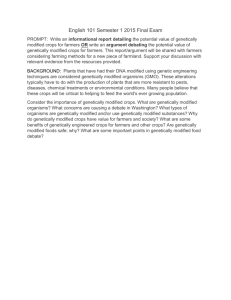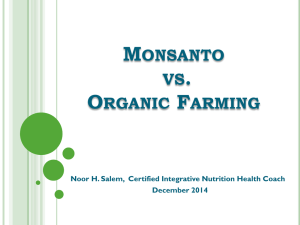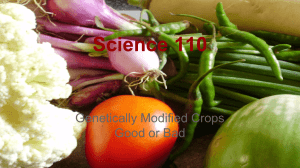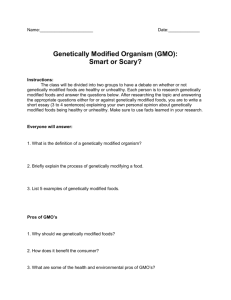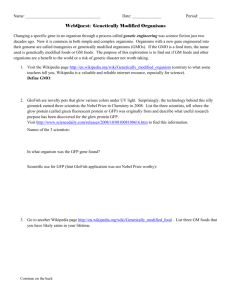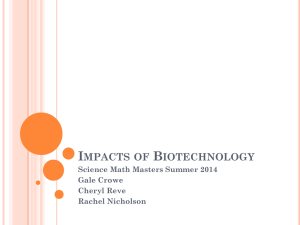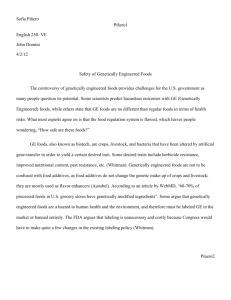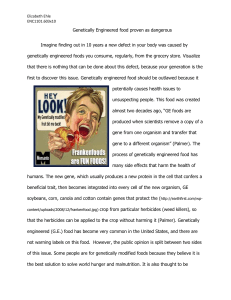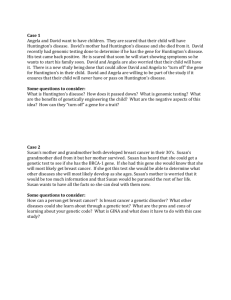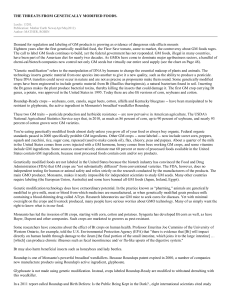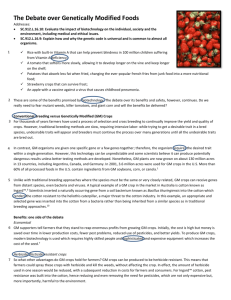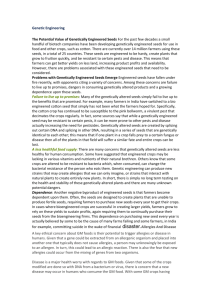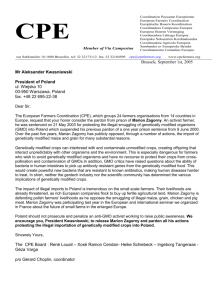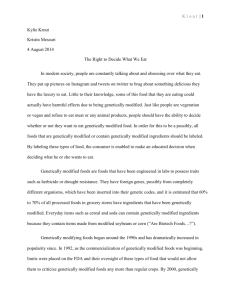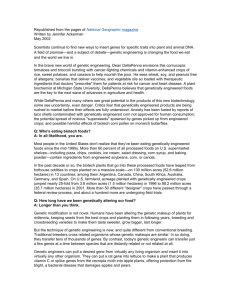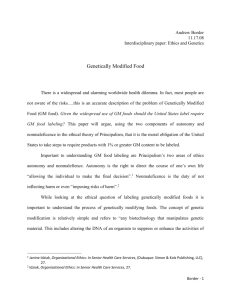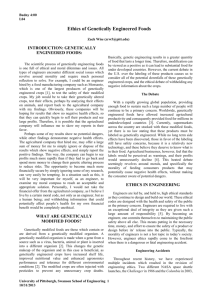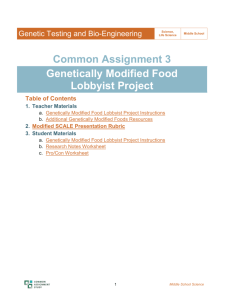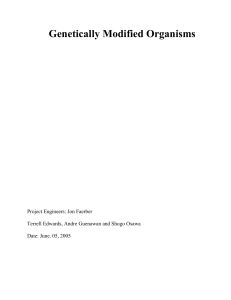GMO Debate Paper
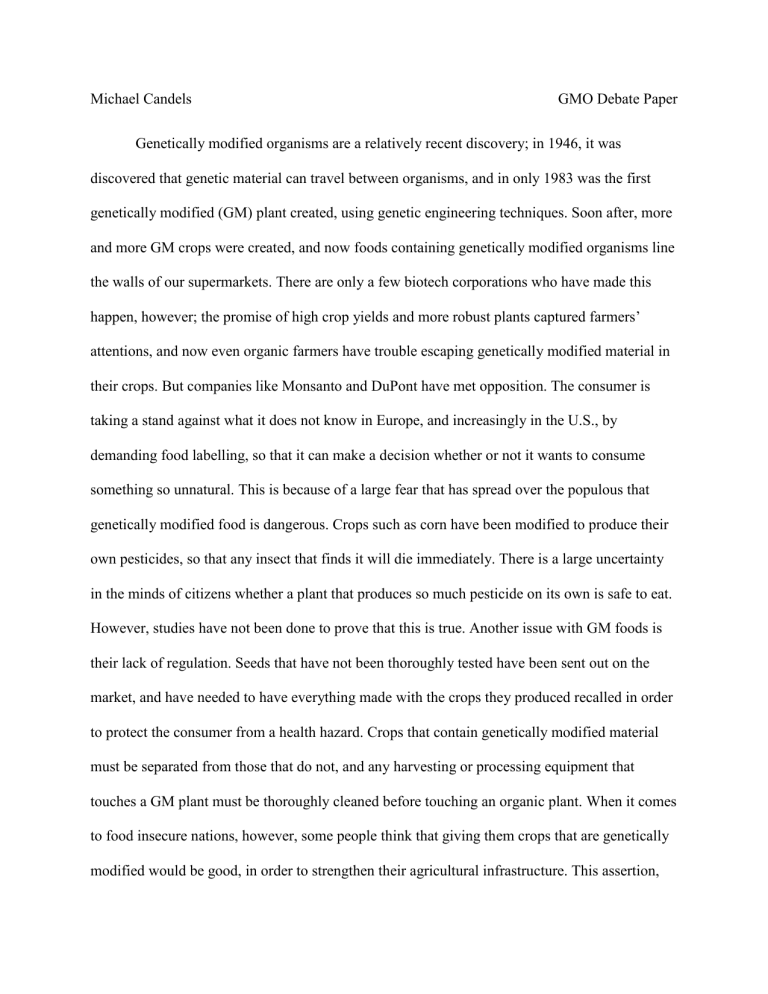
Michael Candels GMO Debate Paper
Genetically modified organisms are a relatively recent discovery; in 1946, it was discovered that genetic material can travel between organisms, and in only 1983 was the first genetically modified (GM) plant created, using genetic engineering techniques. Soon after, more and more GM crops were created, and now foods containing genetically modified organisms line the walls of our supermarkets. There are only a few biotech corporations who have made this happen, however; the promise of high crop yields and more robust plants captured farmers’ attentions, and now even organic farmers have trouble escaping genetically modified material in their crops. But companies like Monsanto and DuPont have met opposition. The consumer is taking a stand against what it does not know in Europe, and increasingly in the U.S., by demanding food labelling, so that it can make a decision whether or not it wants to consume something so unnatural. This is because of a large fear that has spread over the populous that genetically modified food is dangerous. Crops such as corn have been modified to produce their own pesticides, so that any insect that finds it will die immediately. There is a large uncertainty in the minds of citizens whether a plant that produces so much pesticide on its own is safe to eat.
However, studies have not been done to prove that this is true. Another issue with GM foods is their lack of regulation. Seeds that have not been thoroughly tested have been sent out on the market, and have needed to have everything made with the crops they produced recalled in order to protect the consumer from a health hazard. Crops that contain genetically modified material must be separated from those that do not, and any harvesting or processing equipment that touches a GM plant must be thoroughly cleaned before touching an organic plant. When it comes to food insecure nations, however, some people think that giving them crops that are genetically modified would be good, in order to strengthen their agricultural infrastructure. This assertion,
while potentially very helpful in order to actually end world hunger, might cause more harm to these developing and developed nations than good.
In an article titled “GMO Foods: Why We Shouldn't Label (Or Worry About) Genetically
Modified Products”, author Cameron English seeks to dispel the notion that GM foods are bad, promoting them and their beneficial effects to society. He says that “There is no reason to label these generally harmless foods and doing so could create unnecessary concern among the public.” He goes on to say that an important part of GM food is the fact that we know what is in the plants, as opposed to organic food, which is laden with unknown bacteria and other micro-(or even macro-)organisms. He quotes scientist Steve Savage, who says, “We know the exact sequence of the gene, its location in the plant’s chromosomes, what the gene does," Which, in his opinion, makes them far safer. He goes on to rave the helpfulness of GM crops by noting the fact that they can be engineered to use less water or other resources, and be able to grow in whatever environment they desire. The remainder of the article can be summarized by saying that English does not like the “right to know” argument of anti-GMO supporters, asserting that the consumer will think that there is something wrong with them. He thinks that these campaigns should be put to a stop, because experts support GMO’s. While this article predominantly focuses on the argument of whether GM crops should be used in the United States, it touches on multiple important points that address the topic of whether GM crops should be implemented outside of the U.S.; particularly in regards to the point that GM crops can be made to grow in any conditions.
English’s argument in his article is somewhat reasonable, but still has several problems.
He says that only food that is dangerous to a consumer’s health should be specially labelled, but he promotes GM food so much that it seems like having special labels on GM products would be
beneficial to him, for he could chose to eat products he supported, and not ones that could contain things unknown to him, like GM foods’ “natural counterparts”. His quote of Steve
Savage says that scientists know what the genes placed in plant chromosomes do, but that is a misconception. Even scientists cannot take into account exactly what the plant will do with those genes, and what effect the outcome will have on the environment. In addition, he says that plants can be engineered for any environment, however plants interact with their environments, for example BT corn adds extra BT bacteria to the soil, simply by being there, which may lead to negative effects on the environment.
Jeffrey Smith’s article, “Genetically Engineered Foods May Cause Rising Food
Allergies” shows the other end of the spectrum on GM food. This article starts with a quite gripping assertion, saying “These unlabeled genetically modified (GM) foods carry a risk of triggering life-threatening allergic reactions, and evidence collected over the past decade now suggests that they are contributing to higher allergy rates.” Smith goes on to say that while there has long been suspected risks of allergens being in GM foods, no one can surely tell the danger of these crops without feeding them to consumers with allergies, which is considerably dangerous. He follows by saying that studies that have been attempted have failed because they were far too hard to sustain. He switches to mention the danger of genetic engineering, saying
“The process of creating a GM crop can produce massive changes in the natural functioning of the plant’s DNA. Native genes can be mutated, deleted, permanently turned on or off, and hundreds may change their levels of protein expression. This collateral damage may result in increasing the levels of an existing allergen, or even producing a completely new, unknown allergen within the crop.” Smith then mentions an experiment done by allergists that say, of eight patients, one only reacted to a GM soy sample and not an organic one. He says, “Although the
sample size is small, the implication that certain people react only to GM soy is huge, and might account for the increase in soy allergies in the UK.” Smith cites a few other studies and finishes by saying that one should definitely stick to certified organic food in order to protect themselves from the allergenic effects of GM food. This could have negative effects upon food insecure nations, because an increase in allergies among people could lead to even more food insecurity, due to the fact that the people of these nations would be able to eat a smaller variety of food.
This article certainly raises concern for the safety of people who consume products containing GMO’s, however it does appear to lack a solid backing. The article has plenty of sources, however much of the scientific backing seems to be derived from theory rather than a large amount of serious tests. This is shown most specifically in the phrase “Although the sample size is small…”, because the sample was not just small, it was miniscule; and only one of 8 patients did not react to non-GM soy. In the headers of two sections of the article, the author uses terms like “may” and “might” to describe what GM crops do in regards to allergies. The first of these is simply a conclusion drawn from related things. The second is a study done on mice that does not definitively prove much at all about the danger of GM food. While this article does a great job in raising suspicions, it does not appear to be backed up enough by solid facts.
In an article on the Monsanto website called “Labeling Food and Ingredients Developed from GM Seed”, Monsanto takes time to explain its views as a company on the subject of food labelling. It extends the argument of Cameron English’s article, saying that the company supports ensuring total safety of its products. However the company also says that it does not support food labelling laws because crops that are labelled as genetically modified could be seen as inferior or not as safe as the organic crops from others. Clearly the lack of scientific evidence of danger is Monsanto’s strongest argument in the GMO debate.
My perspective on the issue of genetically modified food is that while it is claimed by those who make the food that it is safe, I am skeptical of it. If a food product is made simply be
“safe enough” for human consumption, how healthy can it really be? Genetic engineering is a new technology that is largely not researched, and should be before it is distributed on the scale of the world. Countries that cannot provide enough food for themselves would do better to maintain and attempt to strengthen their agricultural industry, as well as work on increasing the availability of storage methods such as refrigeration. While this is not a fast solution to world hunger, it will protect the world from having even more problems in the future.
Bibliography:
English, Cameron. "GMO Foods: Why We Shouldn't Label (Or Worry About) Genetically
Modified Products." PolicyMic. N.p., 9 Mar. 2012. Web. 25 Oct. 2013.
Smith, Jeffrey M. "Genetically Engineered Foods May Cause Rising Food Allergies." Institute for Responsible Technology. N.p., 2007. Web. 25 Oct. 2013.
"Labeling Food and Ingredients Developed from GM Seed." Monsanto. N.p., n.d. Web. 25 Oct.
2013.

